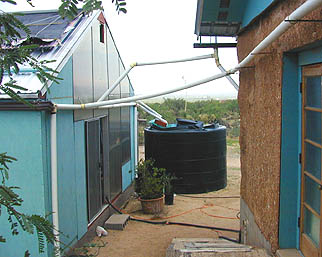
Solar Haven’s Rain Water System
Wells in our area average nearly 1000 feet deep. This is “historical” water which will never be replaced. At today’s prices, a well would cost in the neighborhood of $25,000 — far in excess of our budget.
Ever since we visited New Zealand almost 20 years ago, we have thought about catching and storing the rain from our roof. There we found New Zealanders, rich or poor, collected the rain from their roofs and stored it in barrels or tanks. Wells were the exception rather than the rule, municipal water system almost non-existent. Why not do the same thing in our part of the Sonoran Desert where rainfall averages about 12 inches per year?
We have over 3000 square feet of roof surface to collect rain water between the greenhouse and new straw bale house. TO FIGURE HOW MUCH WATER IS COLLECTED: approximately 600 gallons of rain water is collected for every 1000 square foot of collection area for one inch of rain. Thus one inch of rain produces about 1800 gallons of water and comes close to filling the storage tank. The new above-ground storage pool will hold about 4500 gallons.
There’s even a book which will answer all your questions when you come to install your own rainwater gathering setup – Rainwater Harvesting: The Collection of Rainfall and Runoff in Rural Areas – Buy it from Amazon – 14.95
Initially we used a 2500 gallon polyethylene storage tank to store the rain water from the greenhouse and trailer roofs.
Now the roof of the new straw bale house also has collection gutters and pipes and a 15′ above-ground swimming pool to add to our storage capacity. This is usually kept covered to keep the water from getting dirty and to avoid evaporation — which is significant in the dry Arizona climate.
We have a standard pressure tank and a 1/2 horse power jet pump to bring water from the tank(s) and maintain constant water pressure in the house.
“Roof Washing System”
Roofs get dirty, and the first water caught off the roof is likely to be dirty as well. A simple system to divert this water and discard it (or run it to the garden) rather than letting it go into the storage tank is used. Once the roof washer tube is full (see diagram), water from the roof is free to continue on down the gutter to the storage tank.
Elements of the system and what we paid for them:
* 2500 Gallon Polyethylene Storage Tank – $970
* 85 Gallon Pressure Tank – $355
* 1/2 Horse Power Jet Pump – $325
* 35 Gallon “Reverse Osmosis” Filtering System – $275
* Installation and All Fitings, Valves, and Pipe -$650
* Catchment Gutters and “Water Washing” System – $350
* Used 15′ above-ground swimming pool – $125
* New heavy duty liner for the “pool” – $110
* Gutters and pipes for new straw bale house roof – $125
* Labor to install pipes and gutters – $600
Total Cost: $3,895
3 Responses
nice collections and informations of rainwater harvesting
thank you
Hi All
Recently bought a 2500 litre tank and battled to get fittings for it to convert from down pipe to 40mm fitting on the tank. I also had my fair share of riding around and phone calls for an overflow valve and not to say the least, when I mentioned a roof scrubber, I got a blank stare from more thatn one person. I eventually made the whole lot myself and now tonight I will be fitting the last of the parts.
Is there a non poisonous way in which to keep mosquitoes from laying in my tank? I had a hint that a copper bar floating with a float from a cistern valve will do the trick. Hmmmm! What do you think??
I think it should be manditory in South Africa, where I live, that every house should have a rain tank. We live in a drought area in the southern parts. At the moment the noethern parts are getting floods and they insist that the sun is just a myth spread by us southerners. Ha Ha!! ;-)
My wife was a bit sceptical about this “rain tank” idea, but I convinced her that this is the answer to all. I have a swimminmg pool and it also needs filling ever now and then. We are talking about water restrictions at the moment in our area. Problem is, that some people will comply, others don’t give a rat’s.
My roof scrubber seems to do the trick quite well, if I have to say so myself. Good idea to get rid of the sediment before it lands in the tank. It will obviously not trap everything, but will reduce it by a good percentage.
After this project, it will have to be the off-grid power full time.
Ta
This is the most helpful article I have seen yet!! Real help..real people…